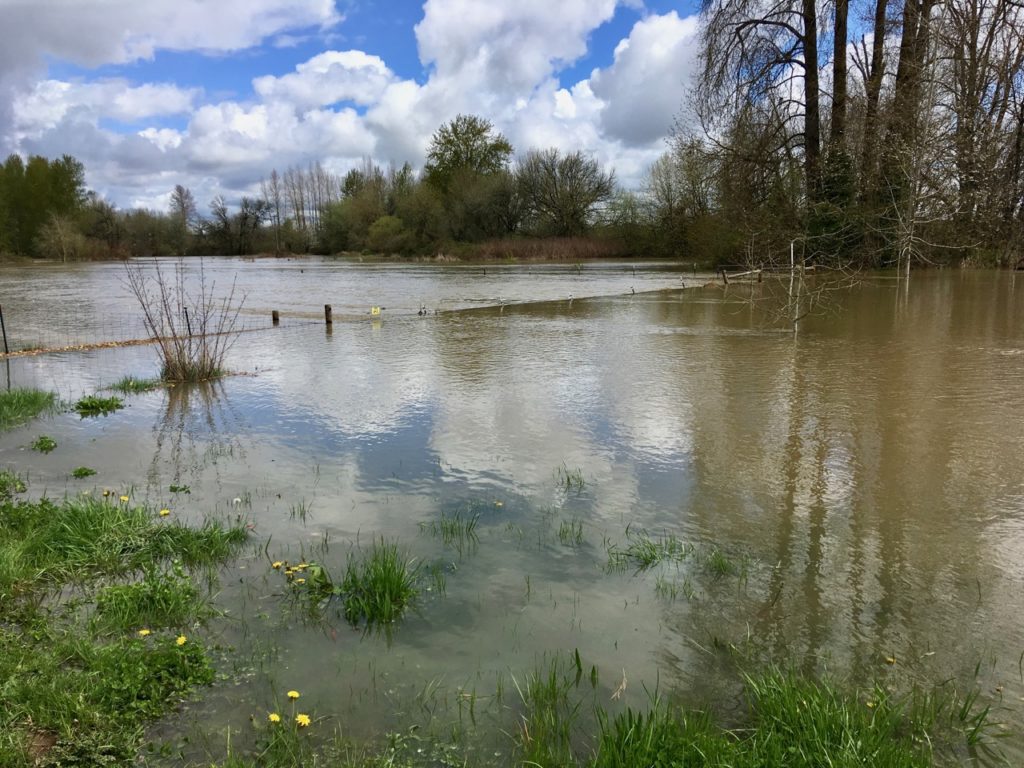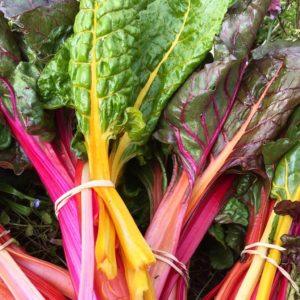
Our lowest ground at the peak of the recent flood event — check out the fence posts that are almost submerged!
After taking several months off from CSA harvest and subsequently also newsletter writing, I have been surprised to resume the rhythm and remember just how full one week on the farm can be! This week was especially eventful because of the recent flood we experienced. I mentioned this was happening in last week’s newsletter, but at the time I was still hoping that it wouldn’t be that big.
But actually by Thursday morning, we were really hoping that we could actually get to the first CSA pick-up of the year, because the water kept rising and rising, and the predicted crest was going up too — and quickly! Over the years of occasional high water events, we’ve carefully observed how water rises here on Grand Island. For us, the lowest field in my parents’ property gets wet first and slowly fills more and more full as the river rises. Next comes a sliver of our field along the creek, which eventually cuts through the orchard closest to our house. At that point, we cross our fingers that it doesn’t go any higher, because the next step is our low hoop houses. Those did in fact flood this last week (in fact they had several feet of water at the peak!). Around the same time that our greenhouses fill, water goes across the road that connects us to our land on the other side of the creek. The timing of that cut-off used to be important when we had animals on pasture over there, but now we rent out that land to another organic farmer.
Finally, the big thing we worry about: the water goes across our road between us and the bridge off the island. On Thursday morning, that road was still open but the river was still rising. It was still clear Thursday night, and we went to bed grateful that we had made it through the first CSA pick-up of the year, but we both had full off-island schedules for Friday! What would we wake up to?
We woke up to water over the road! In the morning it was still shallow enough to drive through, but the river was still rising. So we all left the island with our fingers crossed that we’d be able to get back home. Casey literally brought our tandem kayak and life jackets with him in the back of his pick-up, just in case we would need to paddle our way home.
That evening I was hosting a party for a friend in town, and I was so happy to actually make it to the party I’d been planning for weeks! But, about halfway through the party, my mom texted with an update that the water was higher (and rising), and trucks were struggling to get through. So we said early good-byes and drove both our pick-up and my SUV back to the farm, parked my SUV above the bridge at a generous neighbors’ house and then very carefully approached the water just at dusk not knowing if we’d be wading or paddling or maybe not even getting to our beds at all that evening.
But, hoorah! The pick-up truck made it through, and I can’t remember feeling so grateful for my own bed in a long time.
The water stayed high for a few days, but that was definitely the crest of the event. It peaked at 27.35 ft in Salem, slightly lower than the biggest flood event we’ve experienced back in 2012. (If you’re curious to see the NOAA prediction graph we follow, you can check it out here.)
When the water is high like that, the entire landscape changes and it is beautiful, startling, fascinating and tragic to some. Several of our farmer neighbors suffered losses because of the flood: spring crops that were ready to harvest went under water for one farmer; bee hives for another. Other neighbors who live past certain early-to-go-under roads spent almost a week sleeping away from home — a majorly unplanned interruption in life! We saw some spring-planted crops go under, but now that they’re back out they seem to have survived (and for the most part they weren’t ready to harvest yet anyway). We mostly enjoyed exploring the changed island, especially once we knew we’d met our obligations off-island and could just be home and be present for the event.
Rusty found an exciting discovery in our orchard though during the flood: an injured beaver that was lying, mostly immobile, between two rows of our trees. Without Rusty’s regular rambles, we likely wouldn’t have found it for days and it would have probably died without our noticing it. It had injuries all around its neck and face and seemed to be in a lot of pain. I wasn’t really sure what if anything we could (or should) do for a beaver in this condition, but I reached out to our neighbors to ask. They connected us with Turtle Ridge Wildlife Center in Salem, who explained that I’d need to transport it myself.
I wasn’t immediately comfortable with the logistics of handling a very injured beaver, both not wanting to be injured myself but also not wanting to inflict further harm (or trauma) in my efforts. Thankfully, one of our neighbors (who used to volunteer at Turtle Ridge) offered to come help, and together we loaded her into a kennel and our neighbor drove her to the center. The folks at Turtle Ridge suggested the injuries looked like they were likely from another beaver, and we wondered if the flood had forced her (and potentially other beavers) out of their dens and created situations where beavers were needing to more actively defend their territory than usual. Sadly, her injuries were ultimately too severe for rehabilitation.
Finding, watching, and then handling a beaver on our property felt like a rare opportunity to interact with these mostly shy animals that co-inhabit this place alongside us. While I feel okay about letting nature take its course in such scenarios, I also realized that this opportunity to try and help rehabilitate injured wildlife is a blessing for people as much as for the animals themselves. It felt like an honor to be close to her.
I was also grateful for the opportunity to connect with a neighbor whom we rarely see. Living in a rural area, we have always been stymied by how to naturally interact with all our neighbors as the road is our only shared space and people tend to be private. But events such as floods (and injured beavers apparently!) do provide opportunities for all of us to connect, even if it’s mostly through social media. Although everyone on the island is very unique, we all share the reality of living with a bridge connection to the mainland, and during a flood that’s some important common ground.
And, now? Most of our field is dry or draining. And, the cherries are blooming! And, the sky is blue! And, the spring grass is so so so wonderfully green! Casey and I thoroughly enjoyed harvesting for the CSA together today, rejoicing in the mild weather (after a pretty cold spring!) and the knowledge that we would for sure be able to drive off the island for tomorrow’s pick-up!
We have some beautiful vegetables for you again this week — a continued mix of over-wintered items, storage crops, and spring-planted veggies from the hoop houses. The peas are putting out their blossoms already, and the spring will continue to be an ever-changing season, rich in greens and other good things!
We hope you all enjoyed the first week of our 2019 CSA! Please let us know if you have any questions about your experience so far. Also, we do still have room for more folks if you know someone who is interested!
Enjoy this week’s vegetables!
Your farmers, Katie & Casey Kulla
~ ~ ~
A note about plastic bag usage (& how to reduce them!):
Folks may have noticed that several our items were distributed in plastic produce bags at last week’s pick-up. Over the years, we have researched many options for distributing items in a way that is convenient for our members and also keeps the produce (especially tender greens such as we have now) in the best possible shape. Because most vegetables need to be stored in some kind of container or bag in the fridge, they are ready to pick-up and take home for storage.
However, while we find that plastic bags work well for keeping veggies in good shape during transport and storage, they represent a resource and eventual landfill material. So, to that end, we have several suggestions for people as to how they can reduce their plastic use and still keep their veggies happy.
First, if you choose to take our bags, we ask that you re-use that bag as many times as possible for other uses! That’s a great way to reduce the overall plastic in the world.
Alternately, you could choose to not take a plastic bag. If you bring your own previously used plastic bags (or cloth bags), Casey is happy to fill those for you at pick-up. We have many members who do this weekly, and it requires a slightly longer wait time for them, but they just factor that in to their pick-up. Or, some people just transfer items from bags that are already in the bins to their own bags or basket. If you leave the fresh bags with us, we can re-use them right away.
Thank you for thinking about the best way for you to reduce your plastic bag usage! Please share with us other ideas you may have too!
~ ~ ~
Meet this week’s vegetables:
- Goldrush apples — Have you tried this unique apple variety yet? These are an incredible storage variety that we discovered when we went to put in our orchard. They are a new variety (with loads of good disease resistance) but with the complex flavor profile I expect from heirloom types (which often are susceptible to blight and scab). They also store really really really well in our cooler, meaning that we often eat them more in spring than in the fall when all our other apple types are still available. You can eat these fresh (they are sweet!!!!) or use them to cook (they have good texture that doesn’t just fall apart). Highly recommend you trying these at least once.
- Radishes
- Seasonal salad mix — A mix of tender lettuce, arugula, mizuna. Some of the leaves are larger and could benefit from chopping, but the leaves are very tender so don’t over-dress!
- Arugula
- Mizuna
- Spinach
- Kale
-
Rainbow chard — Casey and I have been farming now for fifteen years if you include our training, and I am still amazed at the vibrant colors possible in a good planting of rainbow chard. This week’s harvest looked especially bright in the soft morning light. It will be delicious too!
- Kale rapini
- Carrots — Don’t let the imperfect exteriors of these carrots fool you! Give them a quick peel and trim, and they are beautiful inside, with delicious flavor suitable for cooking or just eating as sticks (“Ants on a log,” anyone?).
- Potatoes



